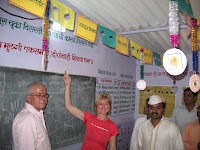
Ban the Bulb, the war-cry of energy efficiency activists in 2007, was temporarily silenced in the first week of 2008 when UK authorities
raised alarm over potential health and environmental risks caused by unsafe disposal of mercury laden CFL bulbs. (Click on the Warning)
It is true that the incandescent bulb, the original invention of TA Edison, wastes huge amounts of energy.
It is also true that coal fired power plants spew amongst other toxic gases, vast quantities of mercury.
But, it is also true that the only efficient alternative,
the CFL bulbs contain around 5 mg of mercury which is a toxic. This hazardous mercury may be released if the bulb is broken, or during disposal.
Efficiency campaigners proclaim that by switching over to CFL bulbs the mercury, CO2 and other toxic emissions from coal fired power plants would be drastically reduced and that the net benefits would be greater than not switching over.
Mitras think that switching over to one hazardous option to reduce another seems pointless when there are other energy efficient lighting options – Light Emitting Diodes more popularly known as LEDs.
LEDs (Light Emitting Diodes) are small, solid light bulbs which are extremely energy-efficient. Until recently, LEDs were limited to single-bulb use in applications such as instrument panels, electronics, pen lights and, more recently, strings of outdoor Christmas lights.
Recent improvements in manufacturing process has lowered the cost of LEDs, and expanded their application. The bulbs are now available in clusters, from 2 to 36 bulbs, and are popular especially for battery powered items such as flashlights and headlamps. LEDs are also available in arrays which fit standard AC and DC receptacles, lamps, recessed and track lights.
LED’s are seen as the next step in lighting, as they last 5 to 10 times longer than CFL’s, have no hazardous materials and last 50,000 hours vs. 10,000 for CFL’s.
LEDs are ideal for use in applications that are subject to frequent on-off cycling, unlike fluorescent lamps that burn out more quickly when cycled frequently.
LEDs can’t and will never be able to match up to the lighting capabilities of incandescent and CFLs, however, if your house is designed correctly LEDs can effectively light up areas using indirect and focus lighting.
They are especially effective in lamps for reading.
Since they use a miniscule amount of power they are also best suited for areas that need to be lit up constantly and where the bulb is difficult to change.
Because of the low power requirement for LEDs, using solar panels becomes more practical and less expensive than running an electric line or using a generator for lighting
.Since LEDs do not have a filament, they are not damaged under circumstances wherein a regular incandescent and CFL bulbs would be broken. Because they are solid, LED bulbs hold up well to jarring and bumping
.LEDs are currently more expensive, price per lumen, on an initial capital cost basis, than more conventional lighting technologies.
However, the government has recognized the need for non toxic lighting alternatives.
Mysore lamps, a defunct PSU is probably going to be revived for assembling LED lamps.
This should make LED lighting more affordable to the general public.
Meanwhile, it is important that the government make compulsory that all CFL bulb packagings print warning/caution sign, indicating presence of mercury and correct disposal practice. It is also imperative that the 'ban the bulb' campaigners train their sights on manufacturers (and distributors) to set in place collection systems for broken and used CFL bulbs at all retail centers.
 The Polar Ice sheet is facing unprecedented thinning, sea-level rise is threatening the very survival of coastal communities but there is no reduction in green house gas emissions, in fact it is accelerating every day, every month, every year.
The Polar Ice sheet is facing unprecedented thinning, sea-level rise is threatening the very survival of coastal communities but there is no reduction in green house gas emissions, in fact it is accelerating every day, every month, every year.






